Flowers are the reproductive organ of most plants. Spermatophytes are the seed plants, and include gymnosperms and angiosperms. Angiosperms have typical flowers that, after fertilization, form seeds enclosed in a fruit. In this page, we will deal with the structure of angiosperm flowers.
1. Flowering
Flowers are formed during the reproductive period of plants by a developmental process known as flowering. The apical shoot meristem changes size, organization and mitotic activity to become a reproductive meristem. Actually, a flower can be regarded as a highly modified shoot where the leaves are dramatically modified to be the components of the flower. All meristematic cells that are part of either a flower or an inflorescence meristem are finally differentiated into mature cells, and the meristem disappears.
2. Components
The flower is connected with the stem by the peduncle, and flowers lacking a peduncle are called sessile. When a peduncle holds a group of flowers, as if they were a bunch, the structure that holds each flower is known as the pedicel. At the distal part, the peduncle, or pedicel, terminal structure referred to as a receptacle is formed, where the other components of the flower are inserted.
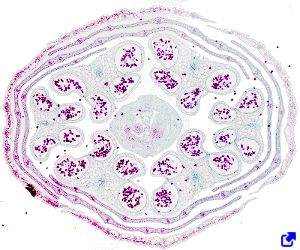
A typical flower have four components (Figure 1): petals, sepals, stamens, and carpels (pistils). The perianth is the non-reproductive part of the flower that has a protective function or helps during fertilization. It consists of the calyx (sepals) and corolla (petals). The reproductive part is composed of the androecium (group of stamens) and the gynoecium (carpels / pistils).
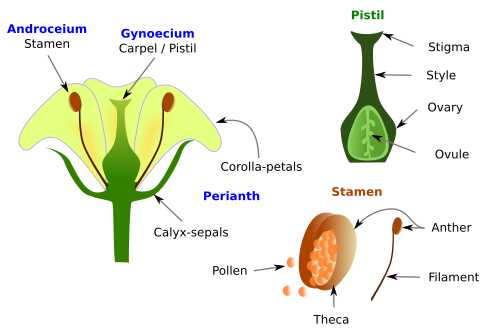
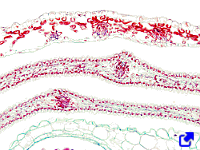
The histological organization of petals and sepals is similar to that of a leaf. Petals show a broad morphological and chromatic variety. Sepals are the main protective structures of the flower, and contain chloroplasts that give them a green color. Sepals are protective structures.
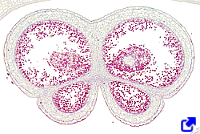
Androecium includes all the stamens of a flower. A typical stamen consists of a filament with the anther at the free end. The anther is usually an elongated structure with a middle groove that separates the two lobes, also known as theca, each containing two pollen sacs. The formation of microspores (microsporogenesis) happens in each of these sacs. Microspores become the male gametophyte, or pollen grain, that produces the male gametes.
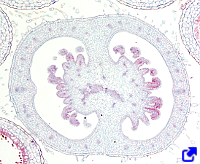
The gynoecium is made up of one or several pistils, each consisting of one or several highly modified leaves known as carpels. Carpels fold to form the typical shape of a bottle or pistil. The wide base of the pistil is the ovary, which contains the ovules. Ovules are more or less round structures connected to the carpel by a filament called the funiculus. The ovule is made up of the nucellus, the female gametophyte (the embryo sac), and one or two outer integuments. Integuments completely wrap the structure, except at the apex, where a channel or passage called the micropyle is present. After fertilization, the seed begins to develop.
The stalk-like structure of the pistil is the style. The ending and sticky part of the style is the stigma. In the ovary, macrosporogenesis, or the formation of macrospore, takes place, resulting in the female gametophyte. Fertilization and the formation of the embryo happens in the female gametophyte, which later becomes the seed.
The receptacle is the structure where the stamens, petals and sepals are inserted. When the ovary rests over the receptacle, it is referred to as a superior ovary. If the receptacle is covering or surrounding half of the ovary height, the ovary is called half-inferior. An Inferior ovary means that the insertion point of flower structures on the receptacle is higher than the ovary (Figure 2).
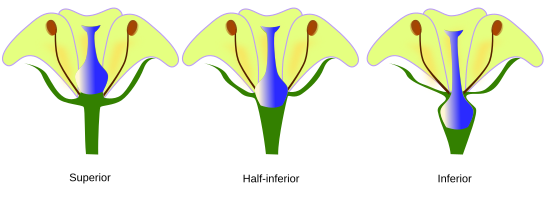
The oculus is the chamber inside the ovary (Figure 3). A flower may have one or several loculi. The Loculus contains the ovules.
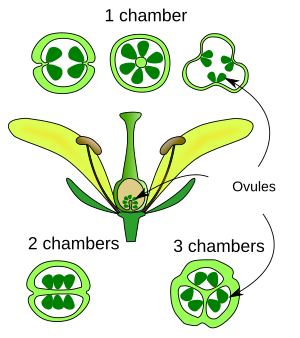
3. Gametophyte
Plants go through two phases during their life cycle: sporophyte and gametophyte. The Sporophyte is the multicellular stage with diploid cells. It is what we commonly see in nature. The gametophyte is the group of haploid cells found within the flowers, and their main role is first to form gametes and, after fertilization, the embryo and the seed.
The angiosperm gametophyte is composed of a few cells. There are two types of gametophytes in plants: female and male. Female gametophyte produces macrospores and male gametophyte produces microspores.
In plants, sexual reproduction begins with sporogenesis. It happens when specialized diploid cells of the sporophyte of the flower go through meiosis and become haploid cells known as spores. Spores are transformed into gametes by gametogenesis, which produces the gametes. Fertilization is the fusion of a female gamete and a male gamete. The zygote is the haploid cells after the fusion of the spores that initiates a new sporophyte.
The female gametophyte develops in the ovary and is composed of three antipode cells, one central, two synergids, and the egg cell (Figure 4). The formation of the female gametophyte follows two stages: macrosporogenesis and macrogametogenesis. Macrosporogenesis consist of three stages: mitosis without cytokinesis, cellularization and cell diferentiation.

Male gametophyte, or pollen grain, is found in the anthers of the stamens. It consists of a generative cell surrounded by a vegetative cell (Figure 5). Male gametophyte is formed by microsporogenesis, followed by microgametogenesis.
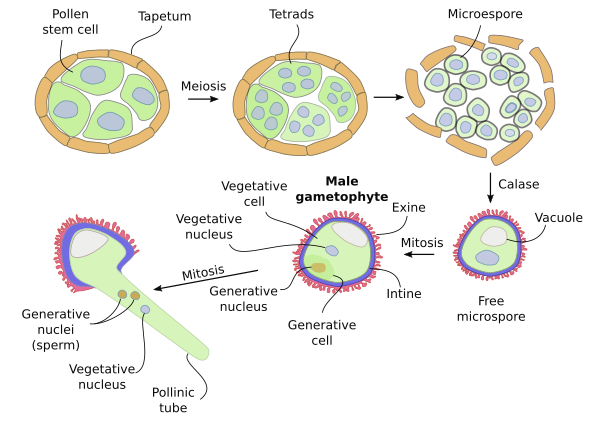
Commonly, the male and female gametophytes (pollen grain and embryo sac, respectively) are found in the same flower. Thus, they are hermaphrodite flowers. However, there are plant species with flowers that have either male or female gametophytes in the same plant (monoecius), and others where male and female gametophytes are found in different plants (dioecieus).